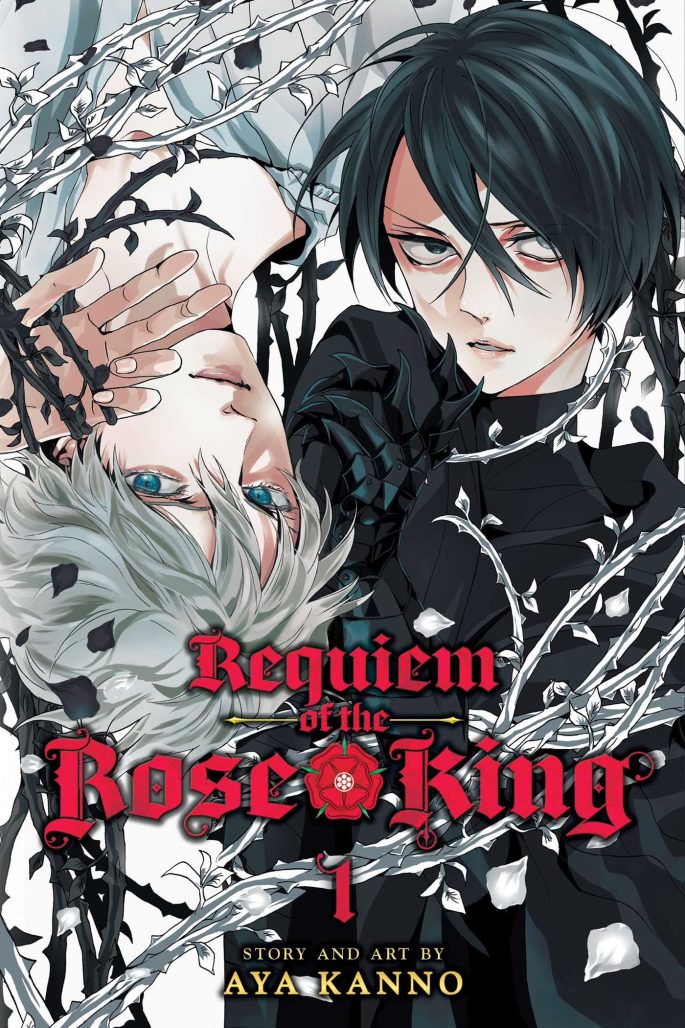With more people reading manga and Webtoons (aka vertical scroll comics) than ever before, Beat’s Bizarre Adventure gives three writers an opportunity each week to recommend some of their favorite books and series from Japan, Korea, and elsewhere. This week we have high school hijinx, a gothic remix of Shakespeare, and, of course, utopia (or is it?)

Suzuki-kun’s Mindful Life
Writer/Artist: Yuhki Fujimoto
Translation: Leighann Harvey
Lettering: Katie Blakeslee
Editors: Sharon Xu, Thomas McAlister
Design: Wendy Chan
Publisher: Yen Press
They say that eyes are a window to the soul. So Suzuki has always been judged by his glaring eyes and towering frame. The truth is, however, that he’s extremely attentive and loves baking, plants and crafts. His soul is as kind as you’ll find! Too bad it doesn’t reflect in his smile.
Suzuki starts high school life with stomach-turning anxiety, fearing that his classmates might judge him for his hobbies. Luckily for him, he befriends Haruna, a classmate who is similarly judged by his appearance, on his first day. Now these kindred spirits navigate the turbulent days of high school life together!
(Before I talk about the series, I’d like to disclose that Yen Press sent me a copy in exchange for an honest review.)
The curtain rises to reveal the embarrassing truth: ever since seeing the Yen Press licensing announcement, I figured this series was a Boys Love manga. Why the cover ticked my gay-(manga-cover)-dar, I don’t know. Whatever the case was, I was in for a pleasant surprise.
Suzuki-kun’s Mindful Life introduces a trope that anime and manga fans, especially romance lovers, are all too familiar with: characters who aren’t as they seem at first glance. In Suzuki’s case, it isn’t only his menacing gaze and intimidating build that are the problem. His hobbies don’t align with what’s considered “normal” for boys to be interested in either.
He’s not only interested in but also good at feminine-coded hobbies or tasks. In the first volume, his dad is away for work and Suzuki handles a good portion of household chores, helps take care of his little sister and supports his working mother. He’s always prepared, be it by carrying snacks, band-aids, or wet wipes. He evokes a motherly feeling in everyone who’s around and sees Suzuki in a positive light.
Suzuki’s self-consciousness and timidness stem from negative experiences that left deep-seated scars in his heart. His mother and sister are huge supporters of him and are always attentive to his moods. They constantly reaffirm that he is perfect the way he is. But Suzuki still has a way to go before he can internalize this.
This first volume is concerned with setting the tone, introducing the characters, establishing new relationships and allowing the reader a peek inside their daily lives. A lot happens, but not much happens at the same time. Series like this usually take one or two volumes to diverge from their peers, if they ever do. Still, Suzuki-kun’s Mindful Life is a fun, cozy read. We all need to read more shojo manga, anyway! — Merve Giray

Requiem of the Rose King
Writer/Artist: Aya Kanno
Translator: Jocelyne Allen
Lettering: Sabrina Heep
Design: Fawn Lau
Editor: Joel Enos
Publisher: VIZ
Every once in a while, a manga emerges that feels less like a conventional story than it does a haunting piece of theater. Aya Kanno’s Requiem of the Rose King is one such work: a gothic re-imagining of Shakespeare’s Richard III and Henry VI, Part 3, set against the blood-soaked backdrop of the Wars of the Roses. First serialized in 2013, the series combines historical drama, Shakespearean tragedy, and an unflinching meditation on identity into something truly unforgettable. If you are a fan of period dramas, you don’t need to read further; just check this out now!
At the heart of the series is Richard, the intersex son of the House of York, torn between a desire for acceptance and the ruthless demands of dynastic warfare. Richard’s father is poised to seize the throne. Yet his downfall plunges the protagonist into grief, rage, and a lifelong struggle with destiny. As battles rage between the houses of York and Lancaster, Richard finds himself entangled with both allies and enemies—each relationship complicated by his ambiguous body, his inner turmoil, and a world unwilling to embrace difference.
What makes Requiem of the Rose King so striking is not only its premise but also its execution. Kanno’s art is drenched in gothic beauty: shadows bleed into page borders, roses and thorns frame moments of despair, and Richard’s very body becomes a canvas for the series’ recurring themes of duality and fracture. The manga is deliberately theatrical. Aya Kanno herself has a background in shōjo manga, and here she pushes the boundaries of the genre into darker, more experimental territory. The decision to re-imagine Richard III as intersex is bold, opening up conversations about gender, otherness, and power rarely seen in historical manga.
On September 16, 2020, Akita Shoten announced through its YouTube channel that Requiem of the Rose King would receive an anime adaptation by J.C.Staff. It proved to be a fitting decision—the anime captures the gothic soul of the manga with reverence. You need to listen to the epic soundtrack that transports you to that period. Even the episode titles feel poetic and devastating, such as the unforgettable line: “After all, this body is just a prison of the soul…” These flourishes elevate the adaptation into more than just a retelling; it becomes a continuation of the work’s artistry.
For me, this story is less about battles and crowns than about Richard himself—a figure both tragic and defiant, beautiful and monstrous. It is a manga that bleeds on the page, unapologetically messy and raw. If you are willing to step into its gothic world, Requiem of the Rose King offers not just a story, but an experience: one that echoes long after the curtain falls. — Ilgın Side Soysal

Land
Writer/Artist: Kazumi Yamashita
Translation: Kevin Gifford
Lettering: Darren Smith
Editing: Madeleine Jose
Platform: KManga (digital), Yen Press (print)
Somewhere there is a small village surrounded by mountains and four great deities. Shamans wearing animal masks govern the people, sacrificing the sick and the infirm. Those who make it to fifty years old “reach chimei” and are granted the honor “to ride the bird to the beyond.”
Eight years ago, Sutekichi was made to sacrifice one of his two twin daughters to appease the gods. Now he lives an ordinary life with his surviving daughter, An. But An is hiding something from him; not so long ago, a bird dropped a bag of seeds at her feet. For the first time, she contemplates the world in which she lives. Why must those who reach chimei disappear? What lies beyond the mountains? Do birds really come from beyond?
Before she knows it, An crosses paths with many eccentric characters. These include: an eccentric lordling kept from sacrifice by a ruler’s favor. A hidden circle of people wearing animal skins in the mountains. A child wearing a mask of human skin who hitches rides with birds where the gods cannot see. Slowly but surely, Land unveils its secrets.
Do you like slow-burn mystery thrillers about utopias hiding dark secrets? I sure do. Kazumi Yamashita’s manga series Land follows in the footsteps of past works like The Giver and From the New World. You know from the jump, before even An does, that her world is built on a skein of lies that will slowly come unraveled. It’s just a question of when it happens, and how explosive the results will be.
Yamashita keeps things moving with a juicy selection of unsettling details (animal masks! ritual sacrifice! religious corruption!) while shrouding the key questions in mystery. Are the gods real? Does this story take place in the past, the present or the future? The first ten chapters answer at least one of those questions, but there’s still plenty left to discover.
Land’s style is rooted in the rough scribbles and big eyes of shojo comics. You can see it most plainly with An, who is always sincere. But even trickier characters, like her blind father Suekichi and the various animal shamans, are readable through how they carry themselves in private. Yamashita never loses sight of each person’s material concerns no matter how big and weird the story becomes. At the same time, her big and weird flourishes (like the giant gods bordering the mountains) are something to see.
While the series is currently available on KManga, Yen Press is putting out a print release starting in September. (They also had copies available at AnimeNYC this weekend, which of course I snapped up.) I couldn’t be more excited; I’ve wanted to read Land ever since I first heard about it. Now it’s in English at last! I can’t wait to see just how deep this rabbit hole goes. — Adam Wescott
Follow Beat’s Bizarre Adventure to get weekly manga and webtoon recommendations!
















!["Superman" (2025) Brings Heart, High Stakes, and Surprising Twists [SPOILER-FILLED REVIEW]](https://www.supermansupersite.com/Superman_2025_Retro_Poster.jpg)




 English (US) ·
English (US) ·